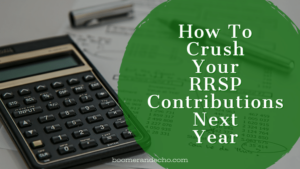 Many high-income earners struggle to max out their RRSP deduction limit each year and as a result have loads of unused RRSP contribution room from prior years.
Many high-income earners struggle to max out their RRSP deduction limit each year and as a result have loads of unused RRSP contribution room from prior years.
While we can debate about whether it’s appropriate for middle and low income earners to contribute to an RRSP or a TFSA, the reality for high-earning T4 employees is that an RRSP contribution is the best way to reduce their tax burden each year.
The RRSP deduction limit is 18% of your earned income from the prior year, up to a maximum of $29,210 in 2022, plus any unused RRSP room from previous years. An employee earning $125,000 per year could contribute $22,500 annually to their RRSP. While that’s straightforward enough, coming up with $1,875 per month to max out your RRSP can be a challenge. An even greater challenge is catching up on unused RRSP room from prior years.
Related: So you’ve made your RRSP contribution. Now what?
Let’s say you live in Ontario, earn a salary of $125,000 per year, and you want to start catching up on your unused RRSP contribution room. Your gross salary is $10,416.67 per month and you have $2,858.92 deducted from your paycheque each month for taxes, leaving you with $7,557.75 in net after-tax monthly income.
Your goal is to contribute $2,000 per month to your RRSP, or $24,000 for the year. This maxes out your annual RRSP deduction limit ($22,500), plus catches up on $1,500 of your unused RRSP contribution room from prior years. Stick to that schedule and you’ll slowly whittle away at that unused contribution room until you’ve fully maxed out your RRSP. Easy, right?
Unfortunately, you don’t have $2,000 per month in extra cash flow to contribute to your RRSP. After housing, transportation, and daily living expenses you only have about $1,200 per month available to save for retirement.
No problem.
That’s right, no problem. Here’s what you can do:
T1213 – Request To Reduce Tax Deductions at Source
Simply fill out a T1213 form (Request to Reduce Tax Deductions at Source) and indicate how much you plan to contribute to your RRSP next year. Submit it to the CRA along with proof – such as a print out showing confirmation of your automatic monthly deposits. The CRA will assess the form and send you back a letter to submit to your human resources / payroll department explaining how they should calculate the amount of tax they withhold for the year.
Note that you’ll need to fill out and submit the form every year. It’s best to do so in early November for the next calendar year so you have time for the form to be assessed and then you can begin the new year with the correct (and reduced) taxes withheld. That said, the CRA will approve letters sent throughout the year – it just makes more sense to line this up with the start of the next calendar year.

Reducing taxes withheld from your paycheque frees up more cash flow to make your RRSP contributions. It’s like getting your tax refund ahead of time instead of waiting until after you file. Let’s see how that would work using our example from Ontario.
You’ve signalled to CRA that you plan to contribute $24,000 to your RRSP next year. In CRA’s eyes, that brings your taxable income down from $125,000 to $101,000. This will make a significant difference to your monthly cash flow.
Recall that you previously had $2,858.92 in taxes deducted from your monthly paycheque. After your T1213 form was assessed and approved, the taxes withheld from your paycheque each month goes down to $1,990.67 – freeing up an extra $868.25 in monthly cash flow that was previously being withheld for taxes. That’s an extra $10,419 that you can use to crush your RRSP contributions next year.
Now, to be clear, you need to follow through and make the $24,000 RRSP contributions that you promised to CRA. Otherwise you’ll face a bigger tax bill for the next tax year, and risk not getting the T1213 form approved again.
Once your T1213 form has been assessed and approved you’ll receive a letter that looks something like this to give to your employer:
The biggest advantage to reducing your taxes withheld at the source is to increase your cash flow so you can make those big RRSP contributions. Otherwise, your options are to take out an RRSP loan to help reach or exceed your deduction limit, or wait for your tax refund and then contribute that lump sum along with your smaller monthly contributions.
Back to our Ontario example, let’s say you did not fill out the T1213 form and instead just contributed your available cash flow of $1,200 per month or $14,400 per year. That would reduce your taxable income to $110,600 and give you a tax refund of $6,251.
You could do anything with that tax refund, and a lot of surveys suggest Canadians are more inclined to spend their refunds because they’re seen as windfalls.
Meanwhile, had you simply filled out the T1213 form and then contributed $2,000 per month to your RRSP, you’d have reduced your tax bill by $10,419 and have nearly $10,000 more saved inside your RRSP.
Who’s crushing it, now?
 In addition to running the Boomer & Echo website, Robb Engen is a fee-only financial planner. This article originally ran on his site on Nov. 17, 2021 and is republished here with his permission.
In addition to running the Boomer & Echo website, Robb Engen is a fee-only financial planner. This article originally ran on his site on Nov. 17, 2021 and is republished here with his permission.


